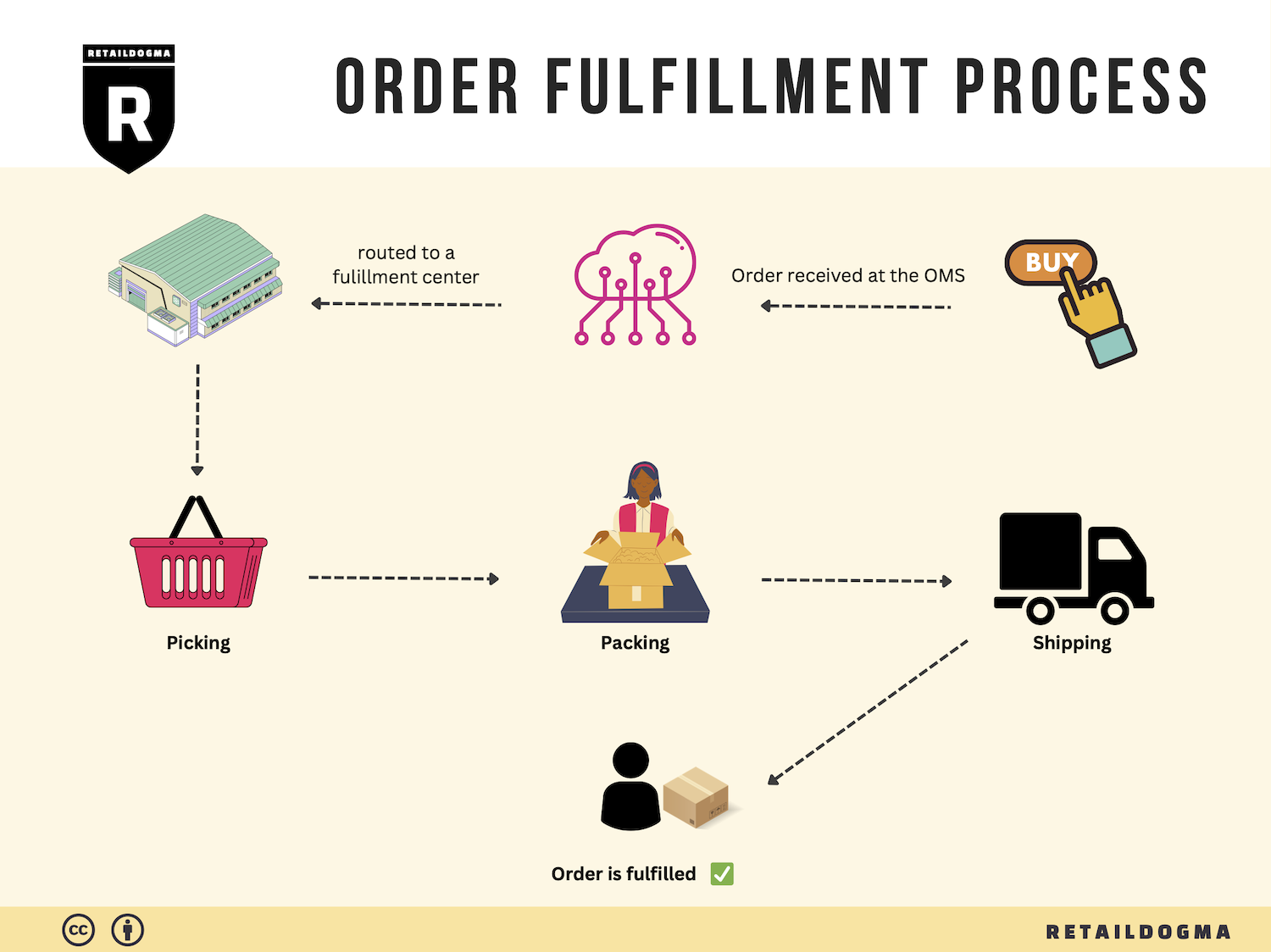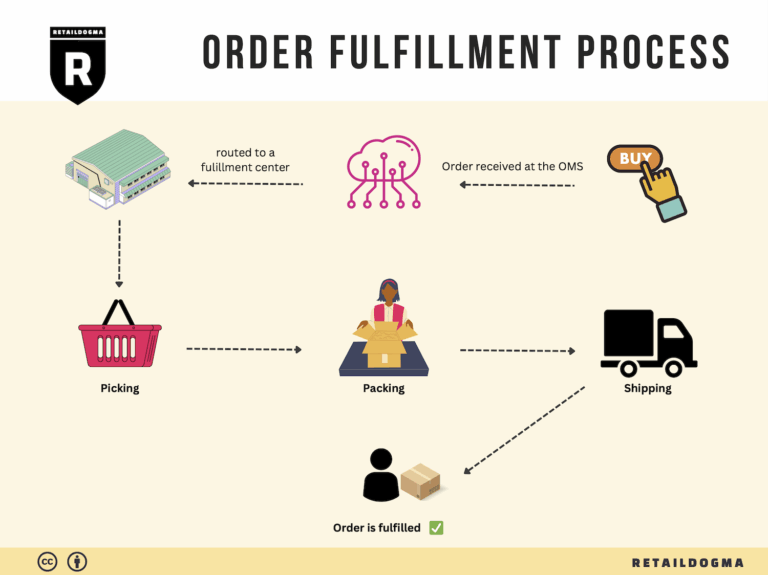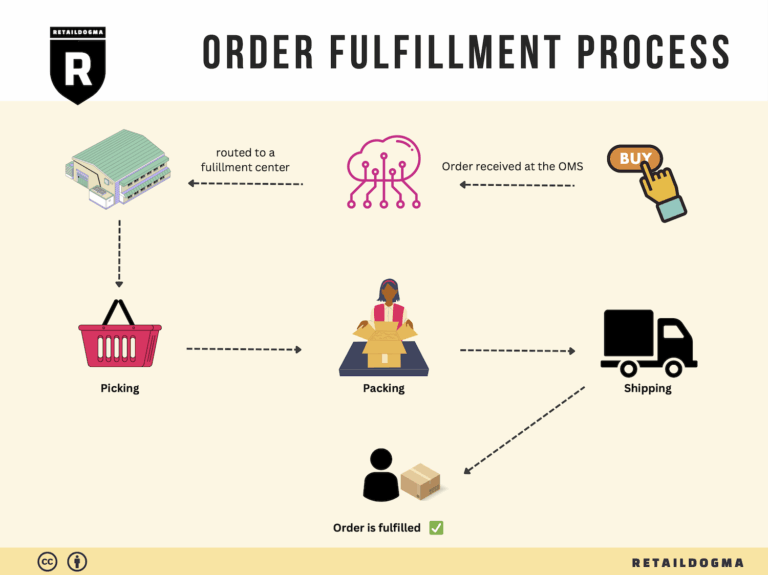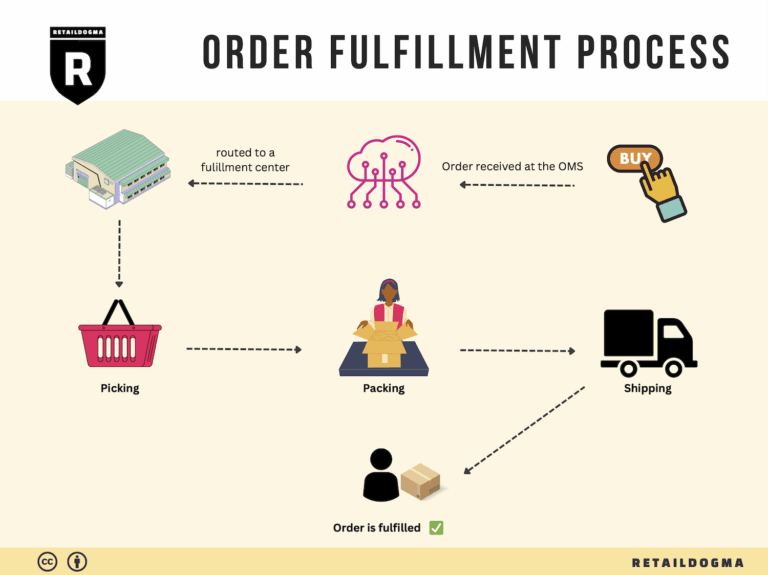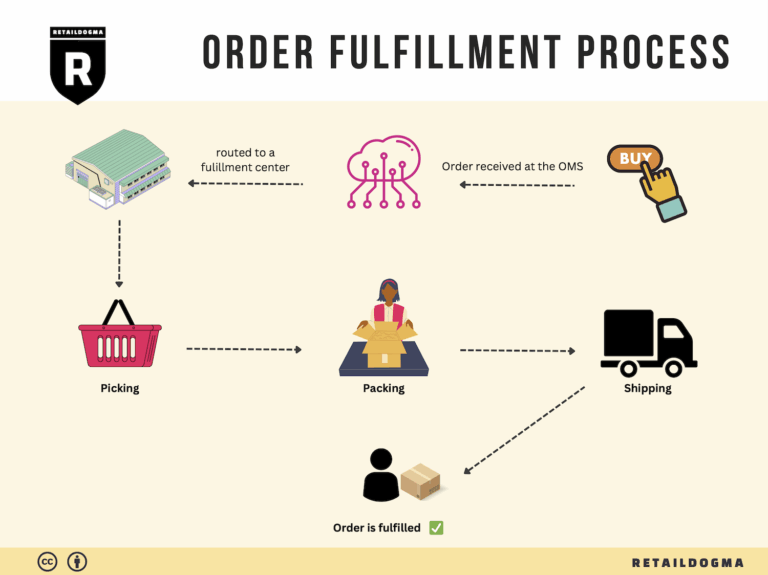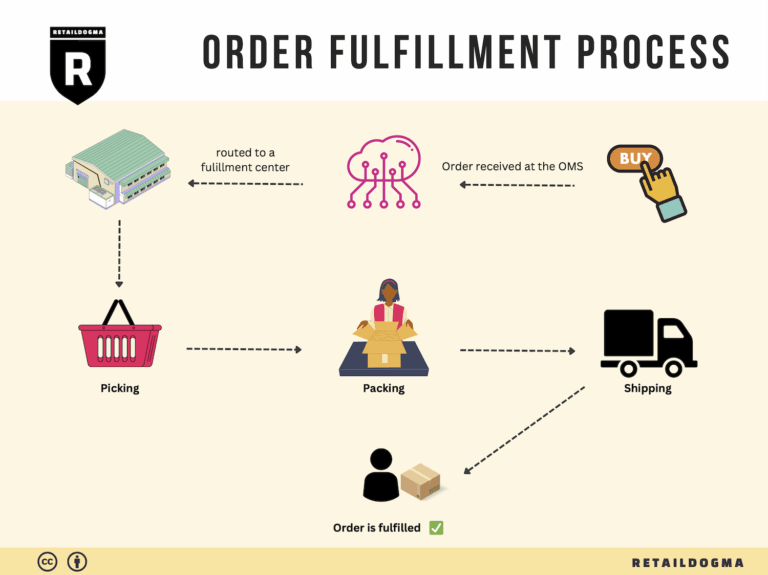Ecommerce Fulfillment Services: The Ultimate Guide (2025)
What is E-commerce Fulfillment? An Introduction for Growing Businesses
Understanding E-commerce Fulfillment: A Key to Scaling Your Business
As your online business grows, the excitement of increased sales can quickly turn into stress when it comes to packing and shipping orders. Many entrepreneurs find themselves overwhelmed with the logistics of fulfilling orders efficiently while still focusing on growth and customer satisfaction. This is where e-commerce fulfillment comes into play—a crucial process that involves getting your products into the hands of customers smoothly and effectively.
At its core, e-commerce fulfillment is the entire journey of a product from your inventory to a customer’s doorstep. This process includes receiving orders, picking products from your inventory, packing them securely, and shipping them out. The efficiency of your fulfillment operations can significantly impact your customer satisfaction, return rates, and ultimately, your bottom line.
In this guide, we will explore the various fulfillment models available to growing businesses, including Fulfilled by Amazon (FBA) and third-party logistics (3PL) providers. Each model has its own advantages and drawbacks, and understanding these can help you make informed decisions that align with your business goals.
We will cover the core services involved in e-commerce fulfillment, such as inventory management, order processing, and shipping solutions. Additionally, we will provide insights on how to choose the right fulfillment partner, taking into account factors like cost, scalability, and service quality. Pricing structures can vary widely between different fulfillment options, so we will also delve into the key costs associated with FBA and 3PL services, helping you to navigate the complexities of logistics expenses.
The ultimate goal of this guide is to empower you as a business owner or operations manager to make strategic decisions about your logistics processes. By understanding the intricacies of e-commerce fulfillment, you can streamline your operations, enhance customer experiences, and position your business for sustainable growth. Whether you are just starting out or looking to scale your existing operations, this comprehensive overview will serve as a valuable resource in your journey toward effective e-commerce fulfillment.
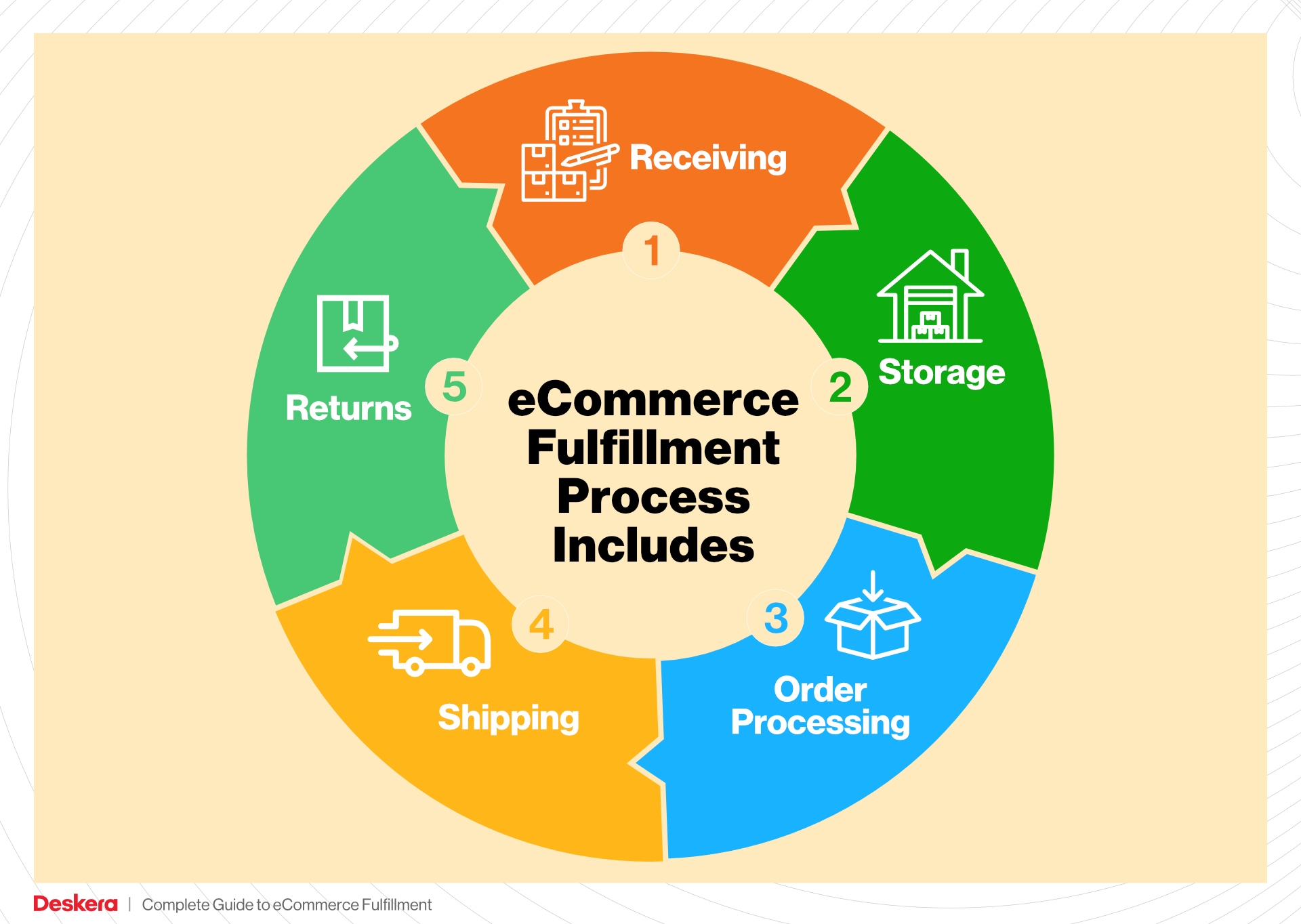
What You’ll Learn In This Guide
- What is E-commerce Fulfillment? An Introduction for Growing Businesses
- The Order Fulfillment Process: From ‘Buy’ Button to Customer’s Door
- Comparing Fulfillment Models: In-House vs. 3PL vs. Dropshipping
- A Deep Dive into Amazon FBA: Pros, Cons, and Who It’s For
- Core Services Offered by Fulfillment Centers
- How to Choose a Fulfillment Partner: A 6-Point Checklist
- Understanding Fulfillment Pricing: A Breakdown of Common Fees
- Frequently Asked Questions (FAQs) about Fulfillment
- Conclusion: Is Outsourcing Fulfillment the Right Move for Your Business?
- Important Disclaimer
The Order Fulfillment Process: From ‘Buy’ Button to Customer’s Door
1. Receiving Inventory
The order fulfillment process begins with receiving inventory at the fulfillment center. This crucial step involves accepting shipments of products from suppliers or manufacturers. Upon arrival, products are checked against purchase orders to ensure accuracy in quantity and quality.
Why It’s Important: Effective inventory receiving minimizes discrepancies and ensures that the right products are available for sale. This process sets the foundation for smooth operations down the line.
Key Term: SKU (Stock Keeping Unit) – Each product is assigned a unique SKU, which aids in tracking and managing inventory levels efficiently.
2. Warehouse Storage
Once the inventory is received and verified, it is organized and stored in designated areas within the warehouse. Proper storage involves categorizing items based on their size, type, and sales frequency. High-demand products may be placed closer to the packing area for quicker access, while less frequently sold items are stored further away.
Why It’s Important: Efficient warehouse storage optimizes space utilization and enhances order fulfillment speed. When products are stored logically, it reduces the time required for order picking, leading to faster delivery times and improved customer satisfaction.
Key Term: Bin Location – A systematic approach to assigning specific locations in the warehouse for different products, which streamlines the picking process.
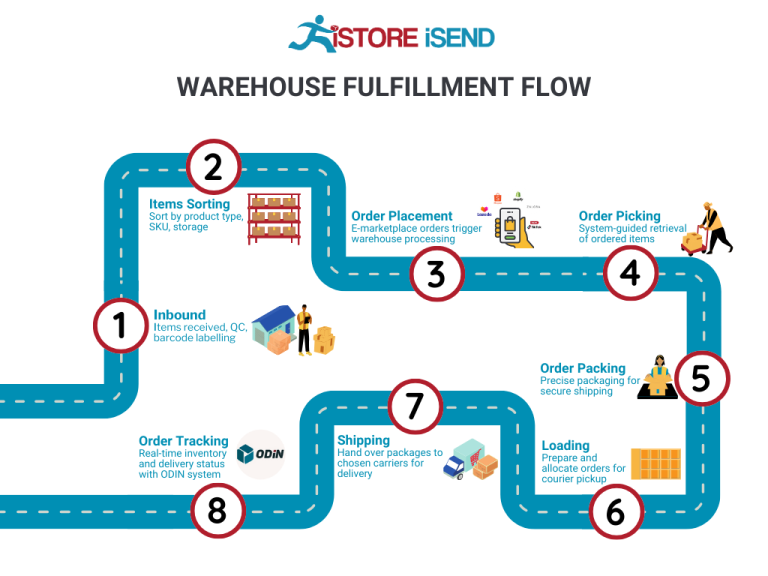
3. Order Picking
Order picking is the process of selecting the right items from the warehouse to fulfill a customer’s order. This step typically involves generating a pick list, which outlines the items and quantities needed for each order. Warehouse staff use the pick list to navigate the storage area and collect the items.
Why It’s Important: Accurate order picking is vital for maintaining customer satisfaction. Errors in this step can lead to incorrect shipments, resulting in returns and diminished customer trust. Moreover, efficient picking practices can significantly reduce labor costs and order turnaround time.
Key Term: Pick List – A document or digital tool that guides warehouse workers in selecting the correct items for fulfillment, ensuring accuracy and efficiency.
4. Order Packing
After items are picked, they are brought to the packing station where they are prepared for shipment. This involves carefully packing products in appropriate packaging materials to prevent damage during transit. Packing also includes labeling the boxes with shipping information and any necessary documentation.
Why It’s Important: Proper packing protects products and enhances the overall customer experience. Thoughtful packaging can also reinforce brand identity and encourage repeat business. Moreover, it is essential for ensuring compliance with shipping regulations and minimizing shipping costs.
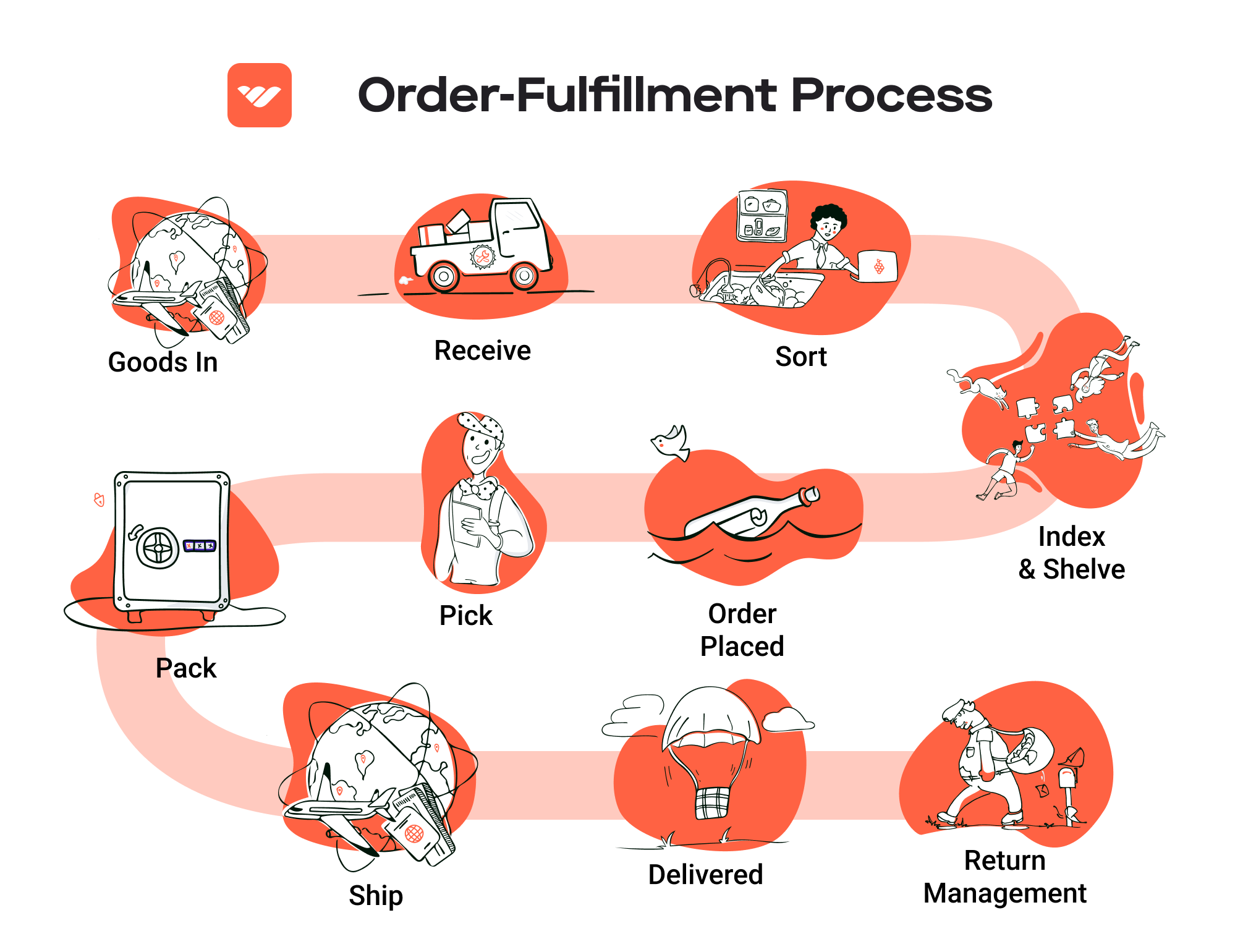
Key Term: Packaging Slip – A document included in the package that outlines the contents of the order, serving as a confirmation for the customer and a record for the business.
5. Shipping & Delivery
The final step in the order fulfillment process is shipping and delivery. Once packed, orders are handed over to shipping carriers for transportation to the customer’s address. Depending on the chosen shipping method, delivery times can vary significantly. Businesses often provide tracking information to customers to keep them informed about their order status.
Why It’s Important: Timely and reliable shipping is critical for customer satisfaction. Delays or issues in this stage can lead to dissatisfaction and lost sales opportunities. Additionally, offering various shipping options can cater to diverse customer needs and preferences.
Key Term: Last-Mile Delivery – The final step in the delivery process where the package is transported from a distribution center to the end customer, often considered the most critical and challenging part of the logistics chain.
By understanding and optimizing each of these five steps in the order fulfillment process, e-commerce businesses can improve operational efficiency, enhance customer satisfaction, and ultimately scale their operations effectively.
Comparing Fulfillment Models: In-House vs. 3PL vs. Dropshipping
Fulfillment Model Comparison
| Model | Who Handles Inventory | Best For (Business Stage) | Key Advantage | Key Disadvantage |
|---|---|---|---|---|
| In-House Fulfillment | The business itself | Established businesses with stable demand | Full control over inventory and fulfillment processes | High overhead costs and resource allocation |
| Third-Party Logistics (3PL) | A logistics provider | Growing businesses looking to scale | Scalability and access to expertise in logistics | Less control over inventory and potential hidden fees |
| Dropshipping | Supplier or manufacturer | Startups and businesses with limited capital | Low upfront investment and no inventory holding costs | Lower profit margins and reliance on suppliers |
In-House Fulfillment
In-house fulfillment refers to the process where a business manages its own inventory and order fulfillment directly. This model is generally best suited for established businesses that have a stable demand for their products and sufficient resources to handle logistics internally. A key advantage of in-house fulfillment is the level of control it provides. Businesses can manage their inventory closely, ensuring that orders are fulfilled according to their specific standards. This control can also extend to branding, as companies can customize packaging and shipping processes to align with their brand identity.
However, the in-house model comes with significant disadvantages. The overhead costs can be high, as businesses must invest in warehousing, staffing, and technology to manage logistics efficiently. Additionally, as order volumes increase, scaling operations can become challenging and may require further investments. This model may also lead to resource allocation challenges, diverting attention from core business activities like marketing and product development.
Third-Party Logistics (3PL)
Third-party logistics (3PL) is a fulfillment model where businesses outsource their warehousing and logistics operations to a third-party provider. This model is particularly advantageous for growing businesses that are looking to scale without the burden of managing logistics themselves. 3PL providers offer expertise and technology that can streamline the order fulfillment process, allowing businesses to focus on their core competencies. A significant advantage of this model is scalability; as demand increases, businesses can easily scale their logistics without having to invest heavily in infrastructure.
However, the reliance on a 3PL provider comes with its own set of challenges. Businesses often have less control over their inventory and fulfillment processes, which can lead to inconsistencies in service quality. Additionally, hidden fees can be a concern; some providers may charge for services that are not initially apparent, affecting overall profitability. It’s crucial for businesses to thoroughly vet potential 3PL partners and understand their pricing structures to avoid unexpected costs.
Dropshipping
Dropshipping is a fulfillment model where businesses sell products they do not physically stock. Instead, when a customer places an order, the business purchases the item from a third-party supplier who then ships it directly to the customer. This model is particularly appealing for startups and businesses with limited capital, as it requires minimal upfront investment and eliminates the need for inventory holding costs. The key advantage of dropshipping lies in its low barrier to entry, allowing entrepreneurs to test markets and product lines without significant financial risk.
However, dropshipping also has notable disadvantages. Profit margins are typically lower compared to other fulfillment models, as the business must pay the supplier’s wholesale price while setting a retail price that remains competitive. Additionally, businesses relying on dropshipping are dependent on suppliers for inventory quality and shipping times, which can lead to customer dissatisfaction if issues arise. This reliance on third-party suppliers also means that businesses have limited control over their brand experience, which can impact customer loyalty and retention.
Conclusion
Choosing the right fulfillment model depends on your business stage, resources, and growth aspirations. In-house fulfillment offers control and branding opportunities but at a higher cost. 3PL provides scalability and expertise but may introduce hidden costs and less control. Dropshipping allows for low investment and flexibility but often results in lower margins and reliance on third-party suppliers. By understanding the strengths and weaknesses of each model, e-commerce business owners can make informed decisions that align with their operational goals and customer expectations.
A Deep Dive into Amazon FBA: Pros, Cons, and Who It’s For
Understanding Fulfillment by Amazon (FBA)
Fulfillment by Amazon (FBA) is a service that enables e-commerce sellers to store their products in Amazon’s fulfillment centers. Once a seller’s inventory is in Amazon’s warehouses, the company takes care of the entire order fulfillment process, which includes picking, packing, shipping, and customer service. This means that when a customer places an order for a product fulfilled by Amazon, Amazon handles everything from the logistics to customer inquiries, allowing sellers to focus on other aspects of their business.
Sellers using FBA can also benefit from Amazon’s extensive distribution network, which allows them to reach a vast customer base and offer services like Prime shipping. However, while FBA can simplify logistics and enhance sales potential, it comes with its own set of challenges and costs that sellers must navigate.
How FBA Works
-
Inventory Shipment: Sellers send their products to Amazon’s fulfillment centers. Depending on the seller’s location and the fulfillment centers’ capacity, Amazon may direct shipments to multiple locations.
-
Storage: Once the products arrive, they are stored in Amazon’s warehouses. Sellers are charged monthly storage fees based on the cubic footage their inventory occupies.
-
Order Processing: When a customer orders a product, Amazon picks it from the warehouse, packs it, and ships it directly to the customer. This process is typically efficient, leveraging Amazon’s sophisticated logistics network.
-
Customer Service: Amazon also manages customer service and returns for FBA orders, which can significantly reduce the burden on sellers.
-
Sales Tracking and Reporting: Sellers can track their inventory levels, sales performance, and other metrics through the Amazon Seller Central dashboard.
Pros of Using FBA
-
Prime Eligibility: Products fulfilled by Amazon are automatically eligible for Amazon Prime, which can significantly boost sales. Prime members are more likely to purchase items that offer free two-day shipping, and having access to this large customer base can lead to increased sales volume.
-
Customer Trust: When customers see that a product is fulfilled by Amazon, they often feel more secure making a purchase. Amazon’s reputation for reliable delivery and customer service can enhance the perceived value of products sold through FBA.
-
Multi-Channel Fulfillment: FBA is not limited to just Amazon sales. Sellers can use FBA to fulfill orders from other sales channels, such as their own e-commerce websites. This flexibility allows sellers to streamline their logistics across multiple platforms.
-
Simplified Logistics: FBA takes care of the storage, packing, and shipping of products, allowing sellers to focus on product development and marketing rather than logistics.
Cons of Using FBA
-
High Fees: One of the most significant drawbacks of FBA is the cost. Sellers incur various fees, including fulfillment fees (which cover picking, packing, and shipping), storage fees, and additional charges for returns, removals, and other services. These costs can add up quickly, particularly for sellers with low-margin products.
-
Strict Inventory Rules: Amazon has stringent inventory management rules, including limits on the quantity of products that can be stored in their warehouses. Sellers must be diligent about monitoring their inventory levels to avoid incurring overage fees or having their inventory removed.
-
Commingling Risks: When using FBA, products may be commingled with those of other sellers. This means that if a customer returns a product, Amazon may not return the exact item that was sent. This can lead to issues with quality control and brand reputation, particularly for sellers of unique or high-value items.
-
Loss of Branding Control: Products shipped through FBA are often sent in Amazon-branded boxes, which can detract from a seller’s brand experience. This lack of branding control can be a concern for businesses focused on establishing a unique identity in the marketplace.
Who is FBA Best For?
Fulfillment by Amazon is an excellent option for a variety of sellers, particularly those who are looking to scale their operations quickly. Here are a few scenarios where FBA may be particularly beneficial:
-
New Sellers: Entrepreneurs who are just starting out can leverage FBA to eliminate the complexities of order fulfillment. This allows them to focus on growing their business without being bogged down by logistics.
-
Sellers with High Sales Volume: Businesses that experience high sales volumes can benefit from FBA’s efficient logistics and quick shipping, which can lead to increased customer satisfaction and repeat purchases.
-
Brands Seeking Prime Access: Companies that want to tap into the Prime customer base will find FBA invaluable, as it provides immediate access to millions of potential customers.
-
Multi-Channel Sellers: Brands that sell on multiple platforms can use FBA to streamline their fulfillment processes, allowing them to manage orders from various sources through a single logistics provider.
In conclusion, while Fulfillment by Amazon can provide significant advantages in terms of sales potential and logistical support, it is essential for sellers to carefully consider the associated costs and operational implications. By understanding the pros and cons of FBA, e-commerce businesses can make informed decisions that align with their growth strategies.
Core Services Offered by Fulfillment Centers
Inventory Management & Warehousing
Inventory management and warehousing are foundational services offered by fulfillment centers that play a crucial role in the e-commerce supply chain. This service involves the systematic storage of products in a fulfillment center’s warehouse, ensuring that inventory levels are accurately tracked and managed.
What It Is:
Fulfillment centers provide dedicated storage spaces for e-commerce businesses to keep their products until they are sold. Advanced inventory management systems are utilized to monitor stock levels, automate reorder points, and manage various inventory metrics. These systems often integrate with e-commerce platforms to provide real-time visibility into inventory status.
Benefits:
1. Optimized Space Utilization: By outsourcing warehousing to fulfillment centers, businesses can save on the costs associated with maintaining their own storage facilities. Fulfillment centers are designed to maximize space efficiency, which can lead to lower overall warehousing costs.
-
Reduced Risk of Stockouts: With effective inventory management, businesses can better predict demand and adjust their stock levels accordingly. This minimizes the risk of stockouts, ensuring that products are available when customers want them.
-
Scalability: As e-commerce businesses grow, their inventory needs can change rapidly. Fulfillment centers allow for easy scaling of storage space without the need for long-term leases or significant capital investment.
-
Data-Driven Insights: Many fulfillment centers provide analytics and reporting tools that help businesses understand their inventory turnover rates, seasonal trends, and customer preferences, enabling better decision-making.
Pick and Pack Services
Pick and pack services are essential for the efficient fulfillment of e-commerce orders. This process involves selecting items from the warehouse (picking) and packaging them for shipment (packing) based on customer orders.
What It Is:
Fulfillment centers employ skilled personnel and automated systems to accurately pick ordered items from inventory and pack them securely for delivery. This service ensures that products are shipped in a timely manner and meet quality standards.
Benefits:
1. Speed and Efficiency: Fulfillment centers leverage optimized workflows and technology to speed up the picking and packing process, significantly reducing order processing times compared to in-house operations.
-
Accuracy: High levels of accuracy in picking reduce the likelihood of shipping errors, which can lead to costly returns and dissatisfied customers. Fulfillment centers often implement barcode scanning and quality checks to ensure the right products are selected.
-
Customization: Many fulfillment centers offer customization options for packaging, allowing businesses to enhance their brand presence through branded boxes, inserts, or custom packing materials. This can improve customer experience and brand loyalty.
-
Order Scalability: During peak seasons or promotional events, fulfillment centers can quickly scale their operations to handle increased order volumes without compromising service quality.
Kitting and Assembly
Kitting and assembly services involve the grouping of various products into a single package, often as part of a promotional offer or a bundled product. This service is particularly beneficial for businesses that sell multi-component items or kits.
What It Is:
In this context, kitting refers to the assembly of individual items into a complete set, ready for sale or distribution. This may include bundling products, assembling components into a finished product, or preparing gift sets.
Benefits:
1. Enhanced Product Offerings: Kitting allows businesses to offer unique product combinations that can attract customers and differentiate them in a competitive marketplace. This can lead to increased sales and higher average order values.
-
Streamlined Operations: By outsourcing kitting and assembly, businesses can focus on their core competencies, such as product development and marketing, rather than the labor-intensive process of assembling products in-house.
-
Cost Efficiency: Fulfillment centers can often perform kitting and assembly at a lower cost due to their specialized equipment and experienced staff. This can lead to savings that can be passed on to customers or reinvested in other areas of the business.
-
Improved Inventory Management: With kitting services, businesses can manage inventory more efficiently by consolidating multiple SKUs into single units. This reduces the complexity of inventory management and improves order accuracy.
Returns Management (Reverse Logistics)
Returns management, or reverse logistics, is the process of handling returned products efficiently and effectively. This service is critical for maintaining customer satisfaction and minimizing losses associated with returns.
What It Is:
Fulfillment centers manage the return process, from receiving returned items to inspecting, restocking, or disposing of them. They also handle the necessary documentation and communication with customers regarding their returns.
Benefits:
1. Customer Satisfaction: A streamlined returns process enhances the overall customer experience. Quick and hassle-free returns can lead to repeat business and positive reviews, which are vital for e-commerce success.
-
Cost Savings: Efficient returns management can help reduce costs associated with processing returns, including shipping and restocking fees. Fulfillment centers often have established processes that minimize the time and resources spent on returns.
-
Data Collection: Returns management provides valuable data about customer preferences and product issues. Analyzing this data can help businesses make informed decisions about product offerings, quality improvements, and inventory management.
-
Environmental Responsibility: Many fulfillment centers offer sustainable returns solutions, including recycling and environmentally friendly disposal methods. This can enhance a brand’s reputation among environmentally conscious consumers.
By leveraging these core services, e-commerce businesses can enhance their operational efficiency, improve customer satisfaction, and ultimately drive growth in a competitive online marketplace.
How to Choose a Fulfillment Partner: A 6-Point Checklist
Location & Warehouse Network
Importance:
The geographical location of your fulfillment partner’s warehouses can significantly affect shipping times and costs. A partner with a strategically located warehouse network can help you reach your customers faster and more efficiently, reducing shipping costs and improving customer satisfaction.
Questions to Ask:
– Where are your warehouses located, and how does that align with my customer base?
– Do you have multiple warehouse locations to facilitate faster shipping?
– How do you handle shipping to international customers?
Technology & Integrations
Importance:
In the fast-paced world of e-commerce, technology plays a crucial role in streamlining operations. A fulfillment partner with robust technology can offer seamless integration with your existing systems, such as e-commerce platforms, inventory management systems, and shipping software.
Questions to Ask:
– What technology do you use for inventory management, order processing, and shipping?
– Can your systems integrate with my e-commerce platform (e.g., Shopify, WooCommerce, Amazon)?
– Do you offer real-time tracking for orders and inventory levels?
– How do you handle updates and system maintenance?
Specializations (e.g., Cold Storage, Oversized Items)
Importance:
Different businesses have unique needs based on their products. If you sell perishable goods, fragile items, or oversized products, it’s crucial to partner with a fulfillment provider that specializes in these areas. This ensures that your products are handled appropriately, reducing the risk of damage and ensuring compliance with regulations.
Questions to Ask:
– Do you have the capability to handle my specific product types (e.g., cold storage, oversized items)?
– What processes do you have in place to ensure product quality during storage and shipping?
– Can you accommodate seasonal fluctuations in demand for specialized products?
Scalability & Capacity
Importance:
As your business grows, your fulfillment needs will evolve. Choosing a partner that can scale with you is essential to avoid disruptions in service as your order volume increases. A partner with ample capacity can also help you manage peak seasons without compromising service quality.
Questions to Ask:
– What is your current capacity, and how do you handle increased demand during peak seasons?
– How do you manage inventory for businesses that experience rapid growth?
– Are there additional fees associated with scaling my operations, and what are they?
Pricing and Contracts
Importance:
Understanding the pricing structure and contract terms of your fulfillment partner is critical to maintaining healthy profit margins. Transparent pricing will help you avoid unexpected fees that could eat into your bottom line.
Questions to Ask:
– What is your pricing model? Is it based on volume, weight, or a flat rate?
– Are there any additional fees for services like returns, storage, or special handling?
– What is the length of the contract, and what are the terms for cancellation or changes?
– Do you offer a trial period or month-to-month agreements?
Customer Support & Reviews
Importance:
Reliable customer support can make or break your fulfillment experience. A partner that offers excellent support can help resolve issues quickly, minimizing disruptions to your business. Additionally, checking reviews can provide insights into the partner’s reliability and service quality.
Questions to Ask:
– What customer support options do you offer (e.g., phone, email, chat)?
– What are your average response times for support inquiries?
– Can you provide references or case studies from similar businesses in my industry?
– How do you handle order discrepancies, damages, or lost shipments?
Conclusion
Choosing the right fulfillment partner is a critical decision for any e-commerce business looking to scale. By using this checklist, you can systematically evaluate potential partners based on key criteria that will impact your operations and customer satisfaction. Take the time to ask the right questions and conduct thorough research to find a partner that aligns with your business goals and can adapt to your evolving needs.
Understanding Fulfillment Pricing: A Breakdown of Common Fees
Initial Setup Fees
When businesses first engage with a fulfillment provider, they often encounter initial setup fees. These costs can include account setup, onboarding, and integration of systems such as inventory management software and e-commerce platforms. The fee structure varies widely based on the provider and the complexity of the setup. Typically, you might expect to pay anywhere from $100 to $1,000 for this phase, depending on the size of your operation and the services required.
To calculate initial setup fees, consider the following factors:
– Integration Complexity: More complex integrations with multiple sales channels or custom software may incur higher costs.
– Training Requirements: If your team needs extensive training on the new system, this can add to the initial fees.
– Hardware Costs: Some providers may require you to purchase specific hardware, such as barcode scanners or printers, which can also contribute to initial costs.
Receiving Fees
Receiving fees are charged when your inventory arrives at the fulfillment center. These fees cover the labor and resources necessary to unload, inspect, and inventory your products. The calculation is usually based on the number of pallets or the volume of goods received.
For instance, you might see a fee of $25 to $50 per pallet, or a per-unit fee that ranges from $0.10 to $0.30, depending on the size and type of items being received. Key factors influencing receiving fees include:
– Volume of Inventory: Higher volumes may result in bulk discounts.
– Condition of Goods: If items require special handling or inspection, additional fees may apply.
– Receiving Capacity: Providers with limited capacity may charge higher fees during peak seasons.
Storage Fees (per pallet/bin)
Storage fees are charged for the space your inventory occupies in the fulfillment center. This fee is typically calculated on a per-pallet or per-bin basis and is charged monthly. Rates can vary significantly based on the provider, the location of the warehouse, and the time of year.
For example, storage fees might range from $5 to $20 per pallet per month or $0.50 to $4.00 per cubic foot. Factors influencing storage fees include:
– Seasonality: During peak seasons, such as holidays, storage fees may increase due to higher demand for space.
– Item Type: Items that are considered hazardous or require special handling may incur higher storage fees.
– Duration of Storage: Long-term storage (beyond a set period, often six months) can incur additional fees, prompting businesses to manage inventory turnover effectively.
Pick & Pack Fees (per item/order)
Pick and pack fees are charged for the labor involved in selecting items from inventory and packing them for shipment. This fee is generally calculated per order or per item, depending on the provider’s pricing model.
Typical pick and pack fees can range from $1.00 to $5.00 per order, with additional costs for each item picked, which may range from $0.10 to $1.00 per item. Key considerations for pick and pack fees include:
– Order Complexity: More complex orders with multiple items may incur higher fees.
– Packing Requirements: Special packaging needs, such as fragile items requiring additional cushioning, can increase costs.
– Volume Discounts: High order volumes can often lead to negotiated discounts.
Shipping Fees
Shipping fees are the costs associated with transporting the packed orders to customers. These fees can vary widely based on the shipping method, destination, and the weight of the package. Commonly, fulfillment providers will pass on their negotiated shipping rates with carriers to businesses.
To give you an idea, domestic shipping fees can range from $5 to $15 for standard shipping, while expedited services can cost significantly more. Factors influencing shipping fees include:
– Shipping Distance: Longer distances generally incur higher costs.
– Shipping Method: Standard, expedited, and international shipping options each have different pricing structures.
– Weight and Dimensions: Heavier or larger packages typically lead to higher shipping fees due to dimensional weight pricing.
Tips for Getting an Accurate Quote
-
Provide Detailed Information: When requesting quotes, supply as much detail as possible about your inventory, order volume, and specific fulfillment needs. This information helps providers give you a more accurate estimate.
-
Ask About All Fees: Ensure you understand all potential fees involved, including those for receiving, storage, picking, packing, and shipping.
-
Negotiate Terms: Don’t hesitate to negotiate fees, especially if you anticipate high volumes. Many fulfillment providers are willing to adjust their pricing structures based on order volume.
-
Consider Seasonal Variations: Be aware that fees may fluctuate based on the time of year, so inquire about any seasonal pricing changes.
-
Request a Trial Period: If possible, engage in a short-term trial to assess the fulfillment provider’s service quality and fee structure before committing long-term.
By understanding these common fulfillment pricing models and their calculations, e-commerce businesses can make informed decisions that align with their operational goals and budget constraints.
Frequently Asked Questions (FAQs) about Fulfillment
1. What are the main costs associated with Amazon FBA?
Amazon FBA costs can be categorized primarily into fulfillment fees and storage fees. Fulfillment fees cover the picking, packing, and shipping of your products and vary based on product size and weight. Storage fees are charged for keeping your products in Amazon’s fulfillment centers and depend on the volume of space your inventory occupies. Additional costs may include long-term storage fees for items unsold for over a year, return processing fees, and unplanned service fees for issues that arise during fulfillment.
2. How do I calculate my Amazon FBA fees?
To calculate your Amazon FBA fees, you need to consider both fulfillment fees and storage fees. Start by identifying the size and weight of your products to determine the appropriate fulfillment fee tier. Next, estimate the monthly storage fee based on the cubic footage of your inventory. Keep in mind that fees can fluctuate based on seasonality and product type, so it’s wise to regularly review your fee structure on Amazon Seller Central.
3. What is the difference between Fulfilled by Amazon (FBA) and Fulfilled by Merchant (FBM)?
FBA allows sellers to store their products in Amazon’s warehouses, with Amazon handling the entire fulfillment process, including shipping and customer service. FBM, on the other hand, requires sellers to manage their own inventory and fulfill orders directly to customers. While FBA often results in faster shipping and greater visibility on Amazon, FBM can offer more control over fulfillment processes and potentially lower costs.
4. What is a 3PL, and how does it relate to Amazon FBA?
A 3PL, or third-party logistics provider, is a service that manages a company’s logistics and fulfillment operations. This includes warehousing, inventory management, and shipping. While FBA is a specific service offered by Amazon, a 3PL can provide more flexibility and customization for businesses that sell on multiple platforms, including their own websites. Choosing between FBA and a 3PL depends on your specific needs, sales channels, and budget.
5. How much do fulfillment services cost on average?
Fulfillment service costs can vary significantly based on several factors, including the size and weight of products, order volume, and specific service requirements. For Amazon FBA, fulfillment fees generally range from $2.29 to $25.56 per unit, depending on the product category. Monthly storage fees can range from $0.56 to $4.28 per cubic foot. For 3PL services, pricing can vary widely, typically based on a per-order basis or monthly storage rates.
6. What are the long-term storage fees in Amazon FBA?
Amazon imposes long-term storage fees on inventory that remains unsold for more than 365 days. These fees are charged at $6.90 per cubic foot or $0.15 per unit, whichever is greater. Additionally, items that have been in storage for 181 days or longer may incur an aged inventory surcharge, which increases over time. Monitoring your inventory turnover is crucial to avoid these additional costs.
7. How can I reduce my Amazon FBA fees?
To minimize Amazon FBA fees, consider strategies such as optimizing your inventory levels to avoid long-term storage fees, using promotional campaigns to boost sales velocity, and ensuring your products are within the optimal size and weight tiers. Additionally, regularly reviewing your pricing and fulfillment strategy can help you identify areas for improvement.
8. What is the difference between a warehouse and a fulfillment center?
A warehouse is primarily used for storing goods, while a fulfillment center is designed for the complete order fulfillment process. Fulfillment centers not only store inventory but also handle picking, packing, shipping, and returns management. This makes fulfillment centers more suitable for e-commerce businesses that require efficient order processing and shipping.
9. Are there additional fees for returns in Amazon FBA?
Yes, Amazon FBA does charge return processing fees for returned items. The fees vary based on the product category, with costs typically ranging from $1.78 to $157.35 per returned unit. It’s essential to factor these potential costs into your pricing strategy and to manage your inventory effectively to minimize returns.
10. What factors affect Amazon FBA fees?
Several factors can influence your Amazon FBA fees, including the size and weight of your products, the time of year (seasonality), the specific product category, and the volume of inventory stored. Additionally, fees can change based on Amazon’s pricing updates, so staying informed through Amazon Seller Central is critical for effective cost management.
Conclusion: Is Outsourcing Fulfillment the Right Move for Your Business?
Evaluating the Benefits of Outsourcing Fulfillment
Outsourcing fulfillment can be a game-changer for e-commerce businesses looking to scale effectively. By leveraging a third-party logistics (3PL) provider, you can save precious time and resources, allowing you to focus on core business activities such as product development and marketing. Fulfillment services streamline the order process, from inventory management to shipping, which can significantly enhance operational efficiency. This efficiency not only speeds up delivery times but also improves customer satisfaction—an essential factor in today’s competitive marketplace.
Moreover, outsourcing fulfillment offers unparalleled scalability. As your business grows, a reliable fulfillment partner can easily adapt to fluctuating order volumes without the need for significant investments in infrastructure or labor. This flexibility is crucial, especially during peak seasons or promotional events, where demand can surge unexpectedly. Additionally, 3PL providers often have the expertise and technology to optimize shipping routes and manage logistics, which can further reduce costs and improve service levels.
However, the success of this strategy heavily relies on selecting the right fulfillment partner. A thorough evaluation of potential providers is essential to ensure they align with your business goals and can meet your unique needs. Consider factors such as their technology capabilities, fulfillment speed, customer service, and overall reliability.
Take Action Today
To determine if outsourcing your fulfillment process is the right next step, consider conducting an audit of your current shipping and logistics operations. Assess the time and costs involved, and weigh them against the potential benefits of partnering with a fulfillment service. This strategic analysis will provide clarity on whether a 3PL provider can enhance your operational efficiency and support your growth objectives. Embrace the opportunity to scale your e-commerce business by exploring fulfillment options that work best for you.
Important Disclaimer
⚠️ Important Disclaimer
The information in this guide is for educational purposes. Fulfillment services, pricing, and platform features change frequently. Always conduct your own due diligence and consult with providers directly before making business decisions.
